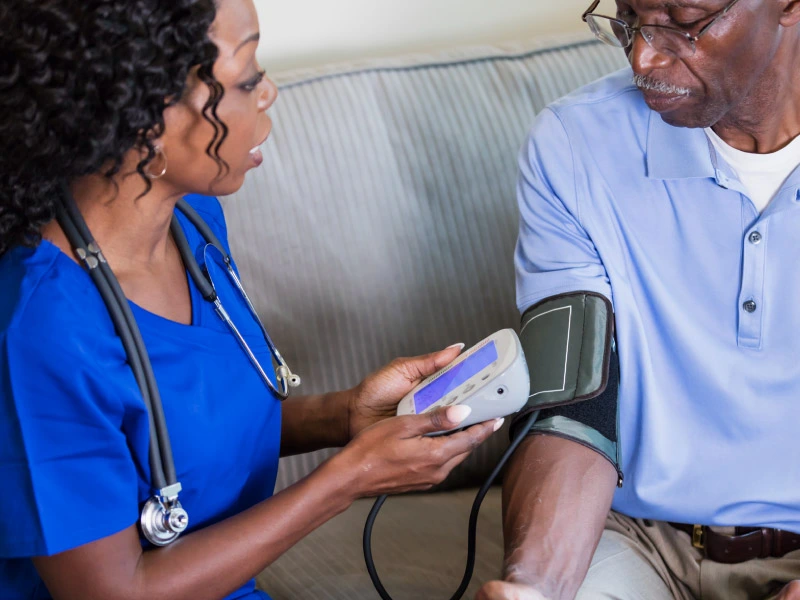Author's details
- Hakim A Abubakre
- BA (Hons) International business management, MSc Digital Marketing.
Reviewer's details
- Dr. Khashau Eleburuike
- MBBS (Ilorin) MSc. Global Health Karolinska Institute.
- Resident doctor in family medicine in Northen Sweden.

- Date Published: 1741651200
- Date Updated: 1741651200
High Blood Pressure (Hypertension)
What is High Blood Pressure?
High blood pressure, also known as hypertension, occurs when the pressure in the blood vessels is consistently too high—typically 140/90 mmHg or greater. It is a common condition that often has no symptoms, making it difficult for individuals to know they have it without a blood pressure check. If untreated, hypertension can lead to serious health problems, including heart disease, stroke, and kidney damage.
- Older age
- Genetics (family history)
- Being overweight or obese
- Physical inactivity
- High salt diet
- Alcohol
Lifestyle changes such as healthy eating, regular exercise, quitting smoking, and avoiding alcohol intake can help lower blood pressure. In some cases, medication is needed to manage the condition.
Blood pressure is recorded as two numbers:
- Systolic pressure (the first number) measures the pressure when the heart contracts (beats).
- Diastolic pressure (the second number) measures the pressure when the heart rests between beats.
High blood pressure is diagnosed when:
- Systolic pressure is 140 mmHg or higher
- Diastolic pressure is 90 mmHg or higher This diagnosis must be confirmed on two separate days.
In some cases, high blood pressure is secondary to an underlying health condition. About 10% of hypertension cases are caused by these conditions:
- Kidney disease
- Diabetes
- Long-term kidney infections
- Sleep apnoea (disruptive breathing during sleep)
- Glomerulonephritis (damage to kidney filters)
- Narrowing of arteries supplying the kidneys
- Hormonal imbalances (e.g., thyroid disorders, Cushing’s syndrome)
- Lupus (an autoimmune disease)
- Scleroderma (a condition causing thickening of the skin and internal organs)
- Contraceptive pills
- Steroids
- Non-steroidal anti-inflammatory drugs (NSAIDs) like ibuprofen and aspirin
- Cough and cold medications
- Some herbal remedies (especially those containing licorice)
- Recreational drugs (e.g., cocaine, amphetamines)
- Some antidepressants (e.g., venlafaxine)
Blood pressure often returns to normal once these medications are stopped.
High blood pressure often has no noticeable symptoms. When symptoms do appear, it is typically in the later stages and may include:
- Moderate to severe headaches
- Anxiety
- Shortness of breath
- Nosebleeds
- Palpitations (feeling of rapid heartbeat)
- Pulsation in the neck
- Chest pain
- Dizziness, nausea, or vomiting
- Blurred vision or vision changes
- Confusion
- Ringing or buzzing in the ears
The treatment plan for hypertension depends on individual needs and includes both lifestyle changes and medications. Lifestyle changes include:
- Weight loss if overweight or obese
- Eating a healthy diet with less fat and salt
- Reducing alcohol consumption
- Regular physical activity, as recommended by a healthcare provider
- Quitting smoking
Medications may also be prescribed to help manage blood pressure. These can include:
- Diuretics
- ACE inhibitors
- Beta-blockers
- Calcium channel blockers Patients must continue taking medications even if they feel fine, as high blood pressure can cause damage without symptoms.
Adopting a healthy lifestyle can help prevent high blood pressure. Here are some preventive measures:
- Eat more fruits and vegetables
- Exercise regularly and avoid prolonged sitting
- Maintain a healthy weight
- Limit salt intake and avoid foods high in saturated or trans fats
- Avoid smoking and tobacco use
- Limit alcohol consumption
- Follow medication instructions as advised by healthcare providers
- Keep regular appointments with healthcare professionals
- Manage stress effectively
Effective management of blood pressure can prevent complications such as heart attack, stroke, and kidney damage. Key steps in reducing hypertension risks include:
- Regularly checking blood pressure
- Managing stress
- Treating underlying health conditions (such as diabetes)
- Maintaining a healthy lifestyle with exercise, diet, and medication compliance
Managing high blood pressure is essential for long-term health and well-being. Regular monitoring and a proactive approach to treatment can significantly reduce the risk of complications.
- WHO Hypertension 16 March 2023. Available at: https://www.who.int/news-room/fact-sheets/detail/hypertension
- https://www.nhs.uk/conditions/high-blood-pressure-hypertension/causes/
- https://www.riversideonline.com/patients-and-visitors/healthy-you-blog/blog/w/what-are-the-symptoms-of-high-blood-pressure#:~:text=Unfortunately%2C%20high%20blood%20pressure%20can,signs%20of%20high%20blood%20pressure.
- https://www.kidney.org/atoz/content/hbptreat
